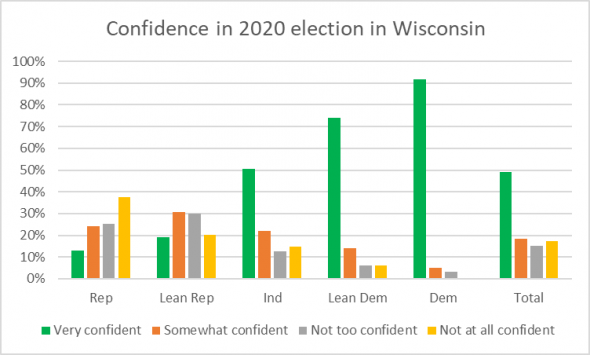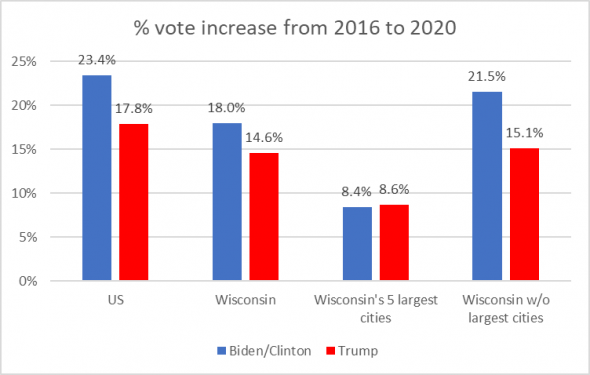Examining Michels ‘Blueprint For Elections’
The GOP businessman candidate for governor offers a very un-business like analysis.

Tim Michels. Photo from Michels for Governor Facebook page.
The Tim Michels campaign webpage includes a section entitled “Tim Michels’ blueprint to restore election integrity.” Michels starts by claiming: “Our plan is simple, we need to make it easier to vote, and harder to cheat.” He then offers a list of items that would make it harder to vote and easier for those in power to cheat. It is essentially a right-wing wish list.
Years ago I moved to Wisconsin from Pennsylvania and was struck by how voter friendly Wisconsin was. It was easy to register. I concluded that Wisconsin trusts its voters. This was a striking change from Philadelphia, where I had to meet with the local election board to appeal their rejection of my voter registration. It has been hard to watch Wisconsin moving more and more in an anti-democratic direction.
Ever since former president Donald Trump’s unsuccessful reelection campaign, there has been a drumbeat of claims on the right asserting that election result cannot be trusted. Michel’s web site fits well within that milieu.
The success of the campaign among those who get their news from the right-wing bubble is reflected in the response to a question on the Marquette Law School Poll. Only 13% of Republicans said they were very confident in the 2020 election, compared to over 90% of Democrats.

Confidence in 2020 election in Wisconsin
Michels’ web page has 13 bullet points listing actions he promises to take if elected. Among these is a “ban on unmanned ballot drop boxes.” This is an example of something that would both make voting less convenient and less secure. Compared to a mailbox, with a drop box the voter is assured that any ballot submitted by 8pm on election day will be counted. Also, the drop box supply chain is inherently less complex than that using a mailbox. The more complex the supply chain, the more that can go wrong.
In Wisconsin, drop box usage exploded with the spring 2020 election in response to the appearance of COVID-19
It is worth noting that conservatives have not always been hostile to drop boxes. In the spring 2020 election at the height of the pandemic, Justice Neil Gorsuch joined the US. Supreme Court majority reversing a lower court decision that would have extended the deadline for submitting absentee ballots in Wisconsin (in Democratic National Committee v. Wisconsin State Legislature). The availability of drop boxes, Gorsuch wrote, made unnecessary such a time extension.
Never mind that voters may return their ballots not only by mail but also by bringing them to a county clerk’s office, or various “no touch” drop boxes staged locally, or certain polling places on election day.
Until election day, voters may, for example, hand-deliver their absentee ballots to the municipal clerk’s office or other designated site, or they may place their absentee ballots in a secure absentee ballot drop box.
Some absentee ballot drop boxes are located outdoors, either for drive-through or walk-up access, and some are indoors at a location like a municipal clerk’s office.
The Wisconsin Elections Commission has made federal grant money available to local municipalities to purchase additional absentee ballot drop boxes to accommodate expanded absentee voting.
The use of drop boxes exploded in Wisconsin with the April 2020 presidential primaries. That election was one of the first in the midst of the COVID–19 pandemic, which turned in-person voting into a health risk, especially for older and less healthy Americans (with its often-long lines, touch screens, and enclosed booths).
Trump’s fingerprints are not limited to lock boxes. On the contrary, they are all over the Michels agenda. One common element is the hostility to the Wisconsin Elections Commission. He promises “repeal of all previous WEC election guidance and freezing the issuance of new guidance.” He would “prohibit re-hiring of any WEC staff that participated in the issuance of any formal guidance that failed to comply with existing law … and create a provision allowing the governor to remove and replace any election official held in contempt of court for failing to immediately cure a polling place violation, including any wrongful denial of observer rights.”
In addition, he promises to “require every county to designate an available election duty judge to be available for hearings on a maximum notice of thirty minutes to hear and resolve emergency Election Day complaints related to polling place violations, including any wrongful denial of observer rights.”
Finally, he would “pass first consideration of the Voter Uniformity Amendment to the Wisconsin Constitution, empowering voters to enforce their civil and constitutional rights and fight back if ever again subjected to such unfairness.” A link supposedly connecting the Voter Uniformity Amendment does not work, so it is unclear what it includes. From the name, it seems likely to end or substantially limit Wisconsin’s tradition of local control of elections.
Why did Trump win the presidency in 2016, only to lose it four years later? The answer is not that it resulted from some plot to steal the election from him. The chart below offers part of the answer. Comparing the two elections, far more people voted in 2020 than in 2016.

% vote increases from 2016-2020
In fact, both candidates—Trump in both years and Clinton in 2016 and Biden in 2020—saw substantial increases. The problem for Trump is that his increase (shown with red bars) was substantially smaller than Biden’s (shown with blue bars). For example, the first pair of bars show that the US vote for Trump grew almost 18% while Biden’s vote grew more 23%.
The same pattern also held for the vast majority of the states. As the next pair of bars this graphic show, Wisconsin (and all 4 or 5 of the other competitive states) also saw greater growth for Biden than for Trump. In 2016 Clinton got almost 3 million more votes than Trump, but still lost the election in the Electoral College. In 2020 Biden got 7 million more votes than Trump. Most of those additional votes made no difference to the outcome of the election. They were cast in safely red states or safely blue states.
Thus, if there were an effort to throw the election to Biden, and it actually worked, one would expect it to show up, either as abnormal votes for Biden or depressed voting for Trump, or perhaps both. There is no indication from the data that either took place.
This grant was greeted with fury by members of the right-wing ecosystem, who charged that it was a thinly-disguised attempt to help the Democrats. At least two lawsuits were brought by groups hoping to switch Wisconsin to Trump, which were quickly rejected by the courts.
More recently, Michael Gableman’s second report was largely devoted to attacking the grant, calling it “Zuckerbucks” because it was largely funded by a gift from Facebook’s founder, Mark Zuckerberg, and accusing the CTCL of practicing bribery. The Tim Michels Blueprint promises that he will make such grants illegal. Notably, none of these attacks offer evidence that partisan considerations entered into awarding the grant. They simply assert that as a fact.
Do the election results suggest that the grant advantaged Democrats? As the third pair of columns shows, both Trump and Biden had the same percentage increase in the five Wisconsin cities. If the same pattern held in the remainder of the state, Biden would have lost. He won because new voters in the rest of Wisconsin chose him over Trump.
Overall I found that the image of Michels resulting from his Blueprint conflicts with his image as a successful businessman. Success in business depends on pragmatism, of being willing to adapt when the facts and circumstances change. The Blueprint reeks of dogma. Consider another of his promises: “Prohibit the closing of regular polling places less than 60 days before an election.” This promise seems to refer to Milwaukee in the spring of 2020. Polling places had to be closed because many of the staffers refused to serve at the height of the pandemic. Does Michels know how to make poll workers magically appear?
It is hard to believe that the author of the “Tim Michels blueprint to restore election integrity” was successful in business.
If you think stories like this are important, become a member of Urban Milwaukee and help support real, independent journalism. Plus you get some cool added benefits.
Data Wonk
-
The Imperial Legislature Is Shot Down
 Jul 10th, 2024 by Bruce Thompson
Jul 10th, 2024 by Bruce Thompson
-
Counting the Lies By Trump
 Jul 3rd, 2024 by Bruce Thompson
Jul 3rd, 2024 by Bruce Thompson
-
How Did Politics Affect Covid Deaths?
 Jun 26th, 2024 by Bruce Thompson
Jun 26th, 2024 by Bruce Thompson




















Dim Tim is icky. there’s not one rCon that’s not bat$hit crazy nowadays.
As the child of a multi-millionaire, Michels never had to, nor has he, ever worked a day in his life.
Tim Michels claims this election blueprint is a plank of his campaign. But, the “plank” seems to be mainly election-denier talking points that speak to people who do not wish to accept election results. The specifics of this “plank” weaken–not strenthen–election integrity by making its oversight strongly political. It is clear where this motivation comes from–Donald Trump has endorsed Tim Michels for governor and used many attempts to attack our democratic process and overturn the election in Wisconsin. Michels in this policy seeks to continue that. The links to the supposed “source” of his background statements still do not work, and on examining the Web page code, there is no link provided. It is notable that Tim Michels’ campaign Web site uses the same logo as his construction company. This doesn’t bode very well for potential customers to know that Tim Michaels uses shoddy planks and a faulty blueprint.
Many conservatives see a Democracy where all citizens can vote as a form of tyranny and desire a authoritarian leader like Viktor Orban of Hungry. Ron DeSantis is in training for this role and wants to be President.
It’s pretty clear that the rCons or the ‘trumpettes’ don’t give a damn about anything other than money and power…….end of discussion.
They will tell any lie to further a destruction of democracy in this state and this country.
They have no plan…..FOR ANYTHING….beyond….something…..something….I won, voter fraud.
Just another rich, entitled, white boy who never had to work a day in his life to get what he wants.
I am a 77 yr. old white woman just so you know.